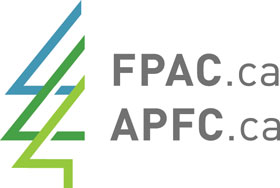
To say that COVID-19 has defined much of what we experienced in 2020 would be the understatement of the century. As we look forward to putting 2020 in the rear-view mirror, I would be remiss in doing my annual ‘look back’ if I did not share our deep appreciation for the incredible efforts and sacrifices of Canada’s frontline health care workers and first responders, and our sympathies to the over 13,600 Canadian families who have lost loved ones due to COVID-19.
The struggle for all of us to find our way started when the World Health Organization declared a global pandemic in early March. Not long after, Canada’s forest sector leadership moved swiftly to work with our partners in government, labour, and across the supply chain to ensure we kept essential products moving, our workers and their families safe, and the Canada/US border open to trade.
The federal government rightly declared that Canadian forest sector workers were essential. We stepped up to ensure that Canadians could get the sustainably sourced, forest-based products they depended on during the pandemic. Things like lumber and wood products for construction and pulp for medical masks, hospital gowns, toilet paper, and sanitary wipes have rarely been in greater demand.
In the first few weeks of the pandemic, the forest sector’s role in the manufacture of personal protective equipment (PPE) came into clear focus. In early April, when US President Donald Trump moved to stop a shipment of 3M masks from entering Canada, it soon became evident that it was premium reinforced pulp from Canada’s northern forests that was a key input to those medical masks – and it gave rise to questions about why we are not doing more to leverage our renewable, homegrown resources to provide for Canadians at a time of urgent need.
The federal government quickly turned to Canadian forestry innovation leaders at FPInnovations to work on a COVID-19 response project to develop a biodegradable, sustainable filter for single-use facemasks made from local, eco-friendly solutions. This made in Canada innovation is now in its second phase and showcases not only the power and nimbleness of Canadian know-how in the forest sector innovation space, but also the opportunity to do more here at home with Canadian forest products. My hope for 2021 is that we continue to learn from the lessons of the pandemic to do more to provide for Canadians with sustainable Canadian resources.
Today, the twin threats of the COVID-19 pandemic and climate change with the accompanying economic stressors are enough to test anyone’s mettle. Canada’s forest sector is resilient, but the COVID-19 crisis has made an already difficult time even more challenging for many forestry families, businesses, and communities. The softwood lumber dispute with the United States continues to be a drag with over $4.3 billion Canadian dollars (and counting) currently held by the US Treasury. This is money that we cannot access to invest in our workforce, make capital improvements, advance product research and innovation, or support export market development. The increased demand for lumber due to a surge in home renovation projects plus a strong North American housing market has been welcome news, but for many who work in pulp and paper segments the market struggles continue.
Despite the challenges before us, we are excited about the potential of our sector and its workforce to help drive a green and inclusive economic recovery. We were proud to see Canada’s forestry workers recognized in the federal government’s recent Speech from the Throne as being leaders in the fight against climate change and the move to rebuild our economy.
To that end, FPAC recently published Innovative, Sustainable, Resilient: Recommendations from Canada’s Forest Sector to Drive Economic Recovery and a Net-Zero Carbon Future. This report captures our unique ability to drive Canada’s post pandemic economic recovery while providing solutions to build an even more sustainable and lower-carbon economy.
This year also saw advances in the use of wood and new mass timber projects in construction not only in Canada but around the world. While architects, engineers, and urban planners are increasingly recognizing the sustainability of these options, the Canadian Wood Council (CWC) is working with technical experts to evolve the National Building Code of Canada to provide safe, effective, and GHG efficient wood construction alternatives.
Whether Canada’s forest products sector is innovating to keep people safe, helping build a lower-carbon economy, or creating economic opportunities for working families, we see an opportunity to accelerate change and advance a recovery that leaves no one behind.
We were pleased to see the Canadian Council of Forest Ministers (CCFM) stand with us when they pledged this fall to increase awareness about the importance of Canada’s world-leading approach to sustainable forest management and the opportunity to better leverage Canadian forests, forestry workers, and forest products to build a lower-carbon economy.
This year brought with it the biggest health and economic crisis of our lifetimes, underscoring the greatest strengths and vulnerabilities of our country. For the forest sector, 2021 opens a window of opportunity to develop a long-term plan to accelerate innovation in the forest bioeconomy and forestry clean tech, make more forest-based products here at home, expand export markets, build bigger and better with Canadian wood, keep communities safer from fire, and get more Canadians working.
Bring on the New Year. We are ready to hit the ground running.

Derek Nighbor
Derek Nighbor is President and CEO of the Forest Products Association of Canada, a voice for Canada’s wood, pulp, and paper producers nationally and internationally in government, trade, and environmental affairs.